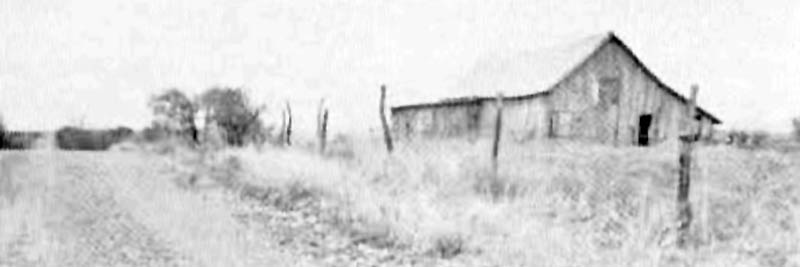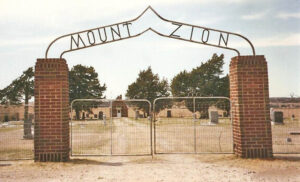
Cave Springs Livery Stable on Broadway Street, which later became a county highway, photo in 1960. W.M. Richards.
Cave Springs, Kansas, south of Indian Creek, is an extinct town in Elk County founded in about 1873.
In the early 1870s, Doctor E.H. Long, known more for his promotional ability than his skill as a physician and surgeon, decided to establish a health resort in Elk County, Kansas. He soon acquired title to 80 acres of land, including a cave and springs. A city plat consisting of a square of 64 blocks was laid out, and lots were sold. Dr. Long kept Block 27, which included the cave and springs, and Block 28, where he would erect a hotel.
Its name was derived from the fact that there is a large overhanging rock which formed a cave. From this cave flowed several springs. The flow of one of the springs varied but little with the change in weather conditions. Even during the extreme dry season of 1936, the flow of this spring was not appreciably diminished.
The water from the springs was the basis for Dr. Long’s promotional activities. Many calls were made for the health-giving and restorative powers of the water from these springs.
Advertisements of this health resort appeared in Eastern newspapers, stating:
“Use the Mineral Waters of Cave Springs for the treatment of rheumatism, neuralgia, dyspepsia, infections of the liver, diseases of the kidneys, bronchial affections, putrid sore throat, external and internal piles, erysipelas, female complaints in their various forms, and all diseases arising from a diseased condition of the blood, such as salt rheum old and obstinate fever sores, etc.”
Before long, patients soon began to arrive.
When the hotel was built, the construction of a water system from the springs into the hotel was included. Thus, water could be pumped from the springs to the hotel for the convenience of those who came to recover their health. The hotel was filled most of the time. As the horse and carriage were the means of transportation between the town and the nearest railroad station, the livery station did a thriving business.
On May 3, 1882, a post office was established called Montrose. At that time, Dr. E.H. Long was still the proprietor of the Springs and the Cave Springs Hotel, and W.C. Getty published the Cave Springs Globe newspaper. H. Valiant was the agent of the Cave Springs Town Company; Robert Moore ran the livery and feed stable; W.R. Adams sold groceries and ran a restaurant; E.F. Reser sold dry goods and groceries and ran the post office; Robert Drake was a druggist and R.W. Rule was a real estate and loan agent and notary public. In July, the Cave Springs-Gould City daily hackline began operating from Howard to Fall River through Cave Springs. Robert Moore & Co. was the proprietor.
On February 11, 1884, the town’s name was changed to Cave Springs.
At its peak, the town boasted a post office, general store, grocery store, drug store, barber shop, doctor’s office, and a newspaper office where a weekly paper was published, a livery stable with a pool room in the loft, a millinery store, and a hotel which had ten sleeping rooms and dining hall service.
Dr. Long did not remain for any great length of time, but Cave Springs began to decline before its promoter departed. Although there were some strong testimonials by people who believed that their health had been greatly improved by drinking from the springs, many of the patients and a majority of the people in our surrounding areas soon began to question the healing properties of the water and even the good faith of Dr. Long. When he realized his bubble was about to burst, he traded his holdings for 300 acres of swamp land in Mississippi. Before he closed out all his interests, a man whose name is no longer remembered became ill while in Cave Springs. This man drove a livestock herd from the west to an eastern market. He was brought to Cave Springs. Always an opportunist, Dr. Long traded his Mississippi land for the livestock herd. Afterward, he disposed of his livestock and left Cave Springs, never to return.
Afterward, the town declined rapidly. The cave was used for a few years to manufacture cheese. The post office, one general store, and the blacksmith remained for several years.
The Cave Springs post office closed on March 31, 1903.
In 1910, Cave Springs was described as an inland hamlet of Elk County, with the nearest railroad station in Fiat, on the Atchison, Topeka & Santa Fe Railroad, five miles west. At that time, it received its mail daily by rural route from Severy, in Greenwood County, about 10 miles northwest.
The blacksmith shop continued to function until old age, and finally, death came to the blacksmith.
On April 2, 1949, Kansas Governor Frank Carlson signed an act of the legislature to “vacate the original Townsite of Cave Springs in Elk County, Kansas, and the streets and alleys of such townsite.”
The only thing left of Cave Springs today is the Mount Zion Cemetery, also known as North Pole Cemetery, located at 2067 Rd 24a, Fall River, Kansas.
Cave Springs was located nine miles northeast of Howard.
Also See:
Sources:
Blackmar, Frank W.; Kansas: A Cyclopedia of State History, Vol I; Standard Publishing Company, Chicago, IL 1912.
Find-a-Grave
Genealogy Trails
Richards, W.M.; Some Ghost Towns of Kansas, Emporia State University.

